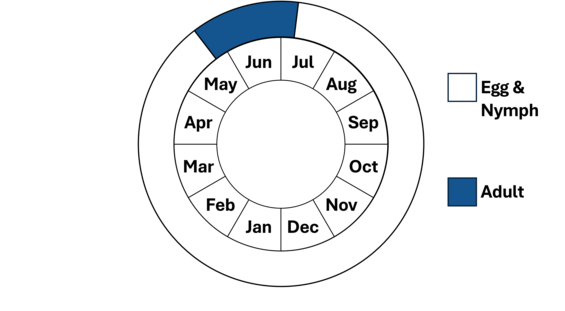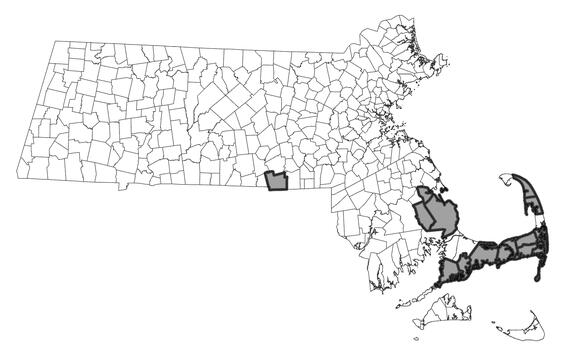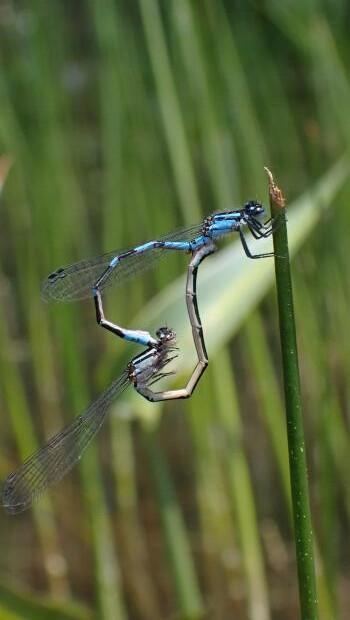- Scientific name: Enallagma recurvatum
- Species of Greatest Conservation Need (MA State Wildlife Action Plan)
- Threatened (MA Endangered Species Act)
Description
Male pine barrens bluet
The pine barrens bluet is a small, semi-aquatic insect of the order Odonata, suborder Zygoptera (the damselflies), and family Coenagrionidae (pond damsels). Like most damselflies, pine barrens bluets have large eyes on the sides of the head, short antennae, and four heavily veined wings that are held folded together over the back. The male’s thorax (winged and legged section behind the head) is mostly blue with black stripes on the “shoulders” and top. The pine barrens bluet has a long, slender abdomen, which is composed of ten segments. The abdominal segments are blue with an increasing amount of black distally through segment 7. Segments 8 and 9 are entirely blue, except segment 8 has a small horizontal black dash on each side of the segment. This mark can sometimes be absent. The top of segment 10 is black. Females have thicker abdomens than the males, and are generally brown where the males are blue, though older females may become quite bluish. Adult pine barrens bluets average 26-29 mm (just over one inch) in length.
The bluets (genus Enallagma) comprise a large group of damselflies, with more than 20 species in Massachusetts. Identification of the various species can be very difficult and often requires close examination of the terminal appendages on the males (Nikula et al. 2007) or the mesostigmal plates (located behind the head) on the females (Westfall and May 1996). The pine barrens bluet is most similar in appearance to, and can co-occur with, the New England bluet (E. laterale). The two species are most safely distinguished by the shape of the terminal appendages on the male and the mesostigmal plates of the females. Also, pine barrens bluet generally have more black on the abdomen (S4-S5), thinner blue shoulder stripe, and thinner to near absent black dash on the sides of segment 8 (Nikula et al. 2007). However, these features do vary and should not be used alone for definitive identification.
Life cycle and behavior

Note adult life stage is synonymous with fight period.
Although little has been published specifically on the life history of the pine barrens bluet, it is likely similar to other, better-studied species in the genus. All odonates have three life stages: egg, aquatic nymph, and flying adult. The nymphs are slender with three leaf-like appendages extending from the end of the body which serve as breathing gills. They have a large, hinged lower jaw which they can extend forward with lightning speed. This feature is used to catch prey, the nymph typically lying in wait until potential prey passes within striking range. They feed on a wide variety of aquatic life, including insects and worms. They spend most of their time clinging to submerged vegetation or other objects, moving infrequently. They transport themselves primarily by walking, but are also capable of swimming with a sinuous, snake-like motion.
Pine barrens bluets have a one-year life cycle. The eggs are laid during the early summer and probably hatch in the fall. The nymphs develop over the winter and spring, undergoing several molts. In early to mid-summer, the nymphs crawl up on emergent vegetation and begin their transformation into adults. Emergence or eclosion typically takes a couple of hours, after which the newly developed adults (tenerals) fly weakly off to upland areas where they spend a week or two feeding and maturing. The young adults are very susceptible to predators, particularly birds, ants, and spiders; mortality is high during this stage of the life cycle. The adults feed on a wide variety of smaller insects which they typically catch in flight.
When mature, the males return to the wetlands where they spend most of their time searching for females. When a male locates a female, he attempts to grasp her behind the head with the terminal appendages at the end of his abdomen. If the female is receptive, she allows the male to grasp her, then curls the end of her abdomen up to the base of the male’s abdomen where his secondary sexual organs (“hamules”) are located. This coupling results in the heart-shaped tandem formation characteristic of all odonates. This coupling lasts for a few minutes to an hour or more. The pair generally remains stationary during this mating but, amazingly, can fly, albeit weakly, while coupled.
Once mating is complete, the female begins laying eggs (ovipositing) in emergent grasses and rushes, using the ovipositor located on the underside of her abdomen to slice into the vegetation where the eggs are deposited. Although the female occasionally oviposits alone, in most cases the male remains attached to the back of the female’s head. This form of mate-guarding is thought to prevent other males from mating with the female before she completes egg-laying. The adult’s activities are almost exclusively limited to feeding and reproduction, and their life is short, probably averaging only three to four weeks. The flight season of the pine barrens bluet is generally restricted to the month of June, with emergence generally occurring during the last week of May. Adults are rarely seen after June.
Distribution and abundance
The pine barrens bluet has a very small range restricted to scattered locations in the northeastern United States. The species is currently found in Massachusetts, Rhode Island, Connecticut, New York and New Jersey, and has the most limited range among the other Enallagma northeast endemics. In Massachusetts, the pine barrens bluet is restricted to coastal plain and occurs in the Blackstone, Taunton, and Cape Cod watersheds, with most occurrences in the latter. Unlike the closely related New England bluet, the pine barrens bluet has occasionally been found in large numbers at some locations, though its overall range is more limited. This species has been documented with high turnover and extinction rates (41%) suggesting dispersal among ponds and a metapopulation structure (Gibbon et al. 2002). This, combined with potentially limiting environmental factors (low and/or high-water levels), may explain recent negative and new positive detections at several sites on Cape Cod (Nikula 2019).
The pine barrens bluet is listed as a Threatened species in Massachusetts and is protected under the Massachusetts Endangered Species Act (MG.L. c.131A) and its implementing regulations (321 CMR 10.00). As with all species listed in Massachusetts, individuals of the species are protected from take (picking, collecting, killing, etc.) and sale under the Massachusetts Endangered Species Act.

Distribution in Massachusetts.
1999-2024
Based on records in the Natural Heritage Database.
Habitat
Pine barrens bluet inhabits lentic systems in the southeastern coastal plain including coastal plain ponds and a few impoundments. Common attributes shared by ponds include sandy shallow shores, large amounts of emergent vegetation close to the shore (Hunt 2020), especially bayonet rush (Juncus militarus; Gibbons et al. 2002), zero to limited pondshore or riparian development, and yearly natural fluctuations in water levels (Hunt 2020). The nymphs are aquatic and live among aquatic vegetation and debris. The adults inhabit nearby forested uplands and emergent vegetation along the shore.
Healthy habitats are vital for supporting native wildlife and plants. Explore habitats and learn about conservation and restoration in Massachusetts.
Coastal plain pond nearshore habitat suitable for pine barrens bluet. Emergent vegetation is Juncus militaris.
Threats
The major threats to pine barrens bluet are shoreline and wetland degradation and loss. Shoreline development may eliminate nearshore/littoral zone and riparian vegetation and harden shorelines through construction of buildings, roads, and other human constructions. Further, shoreline development facilitates increased nutrient and contaminant inputs (e.g., road salts, septic, fertilizer), sedimentation, surface and groundwater withdrawals or water level alteration (e.g., winter drawdown), pesticide use, introduction and spread of invasive species (aquatic vegetation and animals), and recreational activity (e.g., off-road vehicles, boat wakes). These activities lead to wetland/pond degradation that accelerates eutrophication, degrades water quality, and alters or eliminates aquatic vegetation composition required for pine barrens bluet including sedges, rushes, and grasses. Invasive species including Phragmites can replace native emergent vegetation creating unsuitable habitat conditions for pine barrens bluet. In addition, climate change may create unfavorable conditions, including prolonged drought and high-water events, that in combination with ongoing habitat degradation (water withdrawals, nutrient inputs) can increase cyanobacteria blooms, reduce habitat, and alter aquatic vegetation composition unsuitable for the species. High-impact recreational use such as off-road vehicles driving through pond shores, which may destroy breeding and nymphal habitat, and motorboats, whose wakes swamp delicate emerging adults, are also threats. Since pine barrens bluets, spend a period of several days or more away from the pond maturing, and may disperse more than other Enallagma species, it is important to maintain natural upland habitats adjoining the breeding sites for roosting and hunting. Without protected uplands the delicate newly emerged adults are more susceptible to predation and mortality from inclement weather (Hunt et al. 2020).
Conservation
Survey and monitoring
Standardized surveys should target known sites and new wetlands to determine pine barrens bluet occupancy and population status. Surveys for adults are likely to be more effective for detection compared to nymph or exuvia as this life stage is extremely difficult to find and identify. Adult surveys should target nearshore and riparian habitats during their flight period during standardized weather and time windows to maximize species detection. Multiple site visits (e.g., ≥3) are likely required to detect this species because of its typical low abundances and ephemerality. Known sites with breeding evidence should be monitored every 5 years or as needed (i.e., in response to extreme conditions like drought) to document changes in occupancy and habitat conditions. Effort should also be devoted to surveys at potential suitable sites to document potential dispersal and update the species distribution and status in the state.
Management
Protection and restoration of shoreline/littoral zone, riparian, and upland habitat is critical for pine barrens bluet persistence in Massachusetts. Actions that can improve or prevent habitat degradation include: reduction of nutrient, agricultural and road runoff; minimization of water level alteration that impacts native aquatic vegetation; minimization of groundwater withdrawals particularly during drought periods; prevention and management of nonnative aquatic vegetation; development of best practices for herbicide use; limitation and enforcement of off-road vehicles on shoreline habitat; and connection between ponds and other pond complexes.
Research needs
Research effort is needed to estimate detection and occupancy rates and how other environmental variables (e.g., sample timing, weather) affect these rates. Identification of source and sink wetland sites and general population dynamics within and across coastal plain ponds complexes is needed in Massachusetts to prioritize site conservation. Other needed research efforts include estimation of physiological tolerances to insecticides and herbicides; impacts of non-native fish and aquatic vegetation on populations; and projections of species distribution under climate change scenarios and climate vulnerability analysis.
References
Brown, V.A. 2020. Dragonflies and Damselflies of Rhode Island. Rhode Island Division of Fish and Wildlife, Department of Environmental Management, West Kingston RI.
Gibbons, L.K., J.M. Reed, and F.S. Chew. 2002. Habitat requirements and local persistence of three damselfly species (odonata: coenagrionidae). Journal of Insect Conservation 6:47-55.
Hunt, P. 2020. Conservation planning for endemic damselflies of the northeast: A report to the Sarah K. deCoizart Article TENTH Perpetual Charitable Trust. Concord, NH. 18 p.
Hunt, P., V. Brown, R. Butler, P. deMaynadier, L. Harper, L. Saucier, R. Somes, E. White. 2020. A conservation plan for the endemic damselflies of the northeast. 20 p.
Lam, E. 2004. Damselflies of the northeast. Biodiversity Books, Forest Hills, New York, 96 p.
Nikula, B. 2019. A survey for five species of Enallagma (bluet) damselflies in southeastern Massachusetts. Report to Natural Heritage and Endangered Species Program, Massachusetts Division of Fisheries and Wildlife, Westborough, MA.
Nikula, B., J.L. Ryan, and M.R. Burne. 2007. A Field Guide to the Dragonflies and Damselflies of Massachusetts. Massachusetts Natural Heritage and Endangered Species Program.
Walker, E.M. 1953. The Odonata of Canada and Alaska, Vol. I. University of Toronto Press.
Westfall, M.J., Jr., and M.L. May. 1996. Damselflies of North America. Scientific Publishers.
Contact
| Date published: | April 7, 2025 |
|---|
